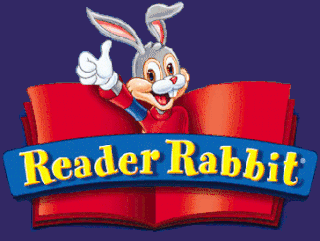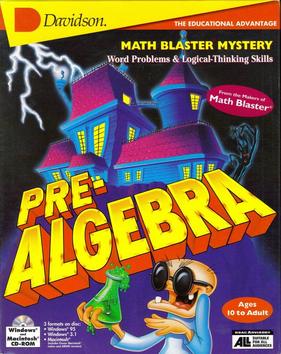JumpStart was an educational media franchise created for children, primarily consisting of educational games. The franchise began with independent developer Fanfare Software's 1994 video game JumpStart Kindergarten. The series was expanded into other age groups and beyond games to include workbooks, direct-to-video films, mobile apps, and other media under the ownership of Knowledge Adventure, which later assumed the name JumpStart Games.
The Learning Company (TLC) was an educational software company founded in 1980 in Palo Alto, California and headquartered in Fremont, California. The company produced a grade-based line of learning software, edutainment games, and productivity tools. Its titles included the flagship series Reader Rabbit, for preschoolers through second graders, and The ClueFinders, for more advanced students. The company was also known for publishing licensed educational titles featuring characters such as Arthur, The Powerpuff Girls, SpongeBob SquarePants or Sesame Street.
Davidson & Associates, Inc. was an American developer of educational software based in Torrance, California. The company was founded in 1984 by husband-and-wife Bob and Jan Davidson, the latter of whom led the company as president until January 1997. Specializing in the production of edutainment software, the company was acquired by CUC International in February 1996 and served as the base for CUC's CUC Software division, being made responsible for the sales and distribution of the combined company.

The Blaster Learning System is an educational video game series created by Davidson & Associates and later published by JumpStart after the two companies were acquired and merged by CUC Software. The games primarily focused on mathematics, later expanding into language arts and science, and spawned an animated children’s television series in 1999 called Blaster's Universe.
Edu-Ware Services, Inc. was an educational and entertainment software publisher established in 1979 by Sherwin Steffin and Steven Pederson. It was known for its adventure games, role-playing video games, and flight simulators for the Apple II series of computers.

Reader Rabbit is an educational video game franchise created in 1984 by The Learning Company. The series is aimed at children from infancy to the age of nine. In 1998, a spiritual successor series called The ClueFinders was released for older students aged seven to twelve.
Singapore math is a teaching method based on the national mathematics curriculum used for first through sixth grade in Singaporean schools. The term was coined in the United States to describe an approach originally developed in Singapore to teach students to learn and master fewer mathematical concepts at greater detail as well as having them learn these concepts using a three-step learning process: concrete, pictorial, and abstract. In the concrete step, students engage in hands-on learning experiences using physical objects which can be everyday items such as paper clips, toy blocks or math manipulates such as counting bears, link cubes and fraction discs. This is followed by drawing pictorial representations of mathematical concepts. Students then solve mathematical problems in an abstract way by using numbers and symbols.
Stickybear is a fictional character created by Richard Hefter and an edutainment series starring the character headed by Optimum Resource. The character was a mascot of Weekly Reader Software, a division of Xerox Education Publications.

Math For The Real World is a 1997 educational video game published by Davidson and Associates and was intended to be the first in a "Real World" game series. On June 30, 1998, Davidson merged with the large educational software company Knowledge Adventure, with the new business becoming the publisher of the game in association with Kaplan Inc.

C-STEM is a UC-approved educational preparation program for undergraduate admission for UC campuses to prepare students for college and career. C-STEM has University of California A-G Program status. High schools can add the A-G approved C-STEM curriculum to their own school’s A-G course lists for the UC/CSU admission requirements.
Madeline is a series of educational point-and-click adventure video games which were developed during the mid-1990s for Windows and Mac systems. The games are an extension of the Madeline series of children's books by Ludwig Bemelmans, which describe the adventures of a young French girl. The video-game series was produced concurrently with a TV series of the same name, with characters and voice actors from the show.

Math Rabbit is a 1986 video game spin-off from the Reader Rabbit edutainment series. It was made by The Learning Company for MS-DOS and Apple II series. A Deluxe version was released in 1993 for MS-DOS, Macintosh, and Windows 3.x. In 1997, the game was remade for Windows and Macintosh as Reader Rabbit's Math 1. The final remake for Windows and Macintosh in 1998 is Reader Rabbit's Math Ages 4-6, with a personalized version released in 1999.

Math Blaster Mystery: The Great Brain Robbery is a product in a line of educational products created by Davidson & Associates that takes place in a different universe from the original Math Blaster. It has no relation to Davidson's earlier Apple II game Math Blaster Mystery. The game was released in North America, Sweden and Spain. The game was remade in 1998 with the title Math Blaster: Pre-Algebra. The game is regarded as a 'Review and Practice' type of software.

Math Blaster! is a 1983 educational video game, and the first entry in the "Math Blaster" series within the Blaster Learning System created by Davidson & Associates. The game was developed by former educator Jan Davidson. It would be revised and ported to newer hardware and operating systems, with enhanced versions rebranded as Math Blaster Plus! (1987), followed by New Math Blaster Plus! (1990). A full redesign was done in 1993 as Math Blaster Episode I: In Search of Spot and again in 1996 as Mega Math Blaster.

Math Blaster Jr. is a 1996 educational video game in the Blaster Learning System series aimed at teaching mathematics to children aged 4–8. The game was rebranded as Math Blaster: Ages 4-6 in 1997.

Gary Bitter is an American researcher, teacher, and author focusing on educational technology. He is Professor of Educational Technology and past Executive Director of Technology Based Learning and Research at Arizona State University. He was a founding board member of the International Society for Technology in Education and served as its first elected president. He is the co-author of the National Technology Standards (NETS) which have been used extensively as a model for National and International Technology Standards.
GAMCO Educational Software was an American educational computer game developer located in Texas. From 1995 it a wholly owned subsidiary of Siboney Learning Group, a division of Siboney Corporation.

Math Blaster for 1st Grade is a 1999 educational video game in a line of educational products originally created by Davidson & Associates and continued by Knowledge Adventure. The game was re-released in 2000 as Math Blaster Mission 2.
Taxman, also known as Tax Factor, Number Shark, The Factor Game, Factor Blast, Factor Blaster, or Dr. Factor, is a mathematical game invented by mathematician Diane Resek.










